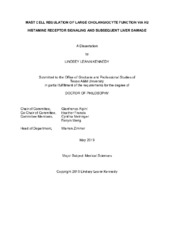| dc.description.abstract | Histamine, synthesized by L-histidine decarboxylase (HDC), is a trophic growth factor that increases biliary damage/proliferation, inflammation, hepatic fibrosis and angiogenesis. Histamine signals through one of four G protein-coupled receptors, H1-H4 histamine receptors (HRs). Cholangiocytes, the epithelial cells that line the biliary tree of the liver, can be subdivided into small (~8 µm in size) and large (~15 µm in size) cholangiocytes, which have phenotypical and functional differences. H1HR is primarily found on small cholangiocytes, whereas H2HR is predominantly found on large cholangiocytes. Mast cells (MCs) (i) infiltrate the liver during cholestasis, (ii) reside near large ducts and (iii) release large amounts of histamine that mediates damage. We aimed to identify the role of MC-derived histamine on large cholangiocyte damage/proliferation via H2HR signaling, and subsequent liver injury in models of cholestasis. We found that bile duct ligation (BDL, a model of cholestasis) induces large cholangiocyte damage, concomitant with increased MC infiltration near large ducts, and promotes liver inflammation, fibrosis and angiogenesis. MC-deficient mice subjected to BDL have reduced large cholangiocyte injury, mediated by decreased H2HR signaling, and reduced liver injury. Reintroduction of MCs into MC-deficient mice enhanced large cholangiocyte H2HR signaling, with an increase in large duct damage, as well as liver inflammation, fibrosis and angiogenesis. Multidrug resistance-2 knockout mice (Mdr2-/- mice, a model of primary sclerosing cholangitis) have increased large duct damage alongside increased H2HR signaling. Consequently, Mdr2-/- mice show increased liver inflammation, fibrosis and angiogenesis. Inhibition of large cholangiocyte H2HR signaling iii by Vivo Morpholino treatment reduced these parameters. In vitro, MCs preferentially migrated towards damaged large, but not small, cholangiocytes. In vitro, large cholangiocytes treated with MC supernatants have increased damage and H2HR signaling, that is ameliorated when MCs are pre-treated with an HDC inhibitor (to block MC-derived histamine). In conclusion, MC-derived histamine promotes large duct damage during cholestasis via H2HR signaling. Increased hepatic MC infiltration and large duct H2HR activation promotes liver inflammation, fibrosis and angiogenesis. Inhibition of MC activation or large duct H2HR signaling reduces these damaging effects. Blocking MCs or large cholangiocyte H2HR activity may be a therapeutic option for patients suffering from large duct damage
. | en |


